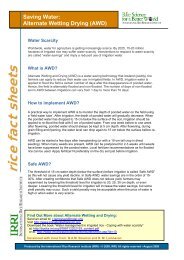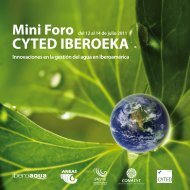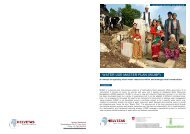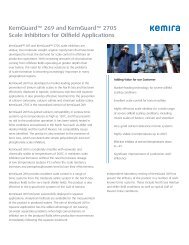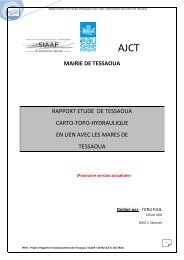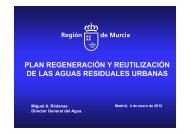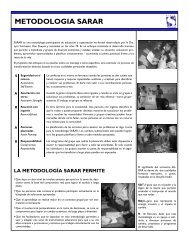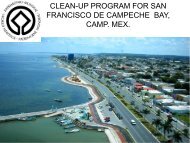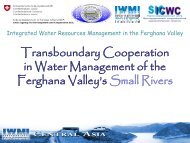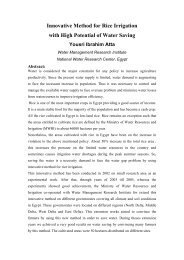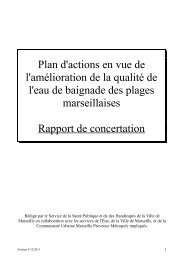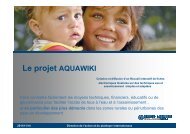Studies of IDRC Supported Research on Greywater in ... - inwrdam
Studies of IDRC Supported Research on Greywater in ... - inwrdam
Studies of IDRC Supported Research on Greywater in ... - inwrdam
You also want an ePaper? Increase the reach of your titles
YUMPU automatically turns print PDFs into web optimized ePapers that Google loves.
19<br />
<strong>in</strong> the first phase, approximately 20 permaculture technologies were identified and<br />
implemented <strong>in</strong> a local k<strong>in</strong>dergarten; while <strong>in</strong> the sec<strong>on</strong>d phase, a revolv<strong>in</strong>g fund was<br />
created which was accessed by poor families <strong>in</strong> the area to implement permaculture<br />
c<strong>on</strong>cepts <strong>on</strong> their lands. As part <str<strong>on</strong>g>of</str<strong>on</strong>g> the project, water harvest<strong>in</strong>g and untreated<br />
greywater reuse were employed. Around fifty families utilized the revolv<strong>in</strong>g fund<br />
facility to establish permaculture pilot projects and greywater reuse systems <strong>in</strong> their<br />
household plots.<br />
After the project completi<strong>on</strong>, the Internati<strong>on</strong>al Development <str<strong>on</strong>g>Research</str<strong>on</strong>g> Center (<str<strong>on</strong>g>IDRC</str<strong>on</strong>g>)<br />
funded INWRDAM to c<strong>on</strong>duct a post appraisal <str<strong>on</strong>g>of</str<strong>on</strong>g> the project <strong>in</strong> terms <str<strong>on</strong>g>of</str<strong>on</strong>g> its susta<strong>in</strong>ability<br />
to determ<strong>in</strong>e viability <str<strong>on</strong>g>of</str<strong>on</strong>g> replicat<strong>in</strong>g the project <strong>on</strong> a larger scale. The evaluati<strong>on</strong> focused<br />
<strong>on</strong> identify<strong>in</strong>g possible risks to human health and envir<strong>on</strong>ment, determ<strong>in</strong><strong>in</strong>g socioec<strong>on</strong>omic<br />
impacts through identify<strong>in</strong>g the benefits and drawbacks <str<strong>on</strong>g>of</str<strong>on</strong>g> the project,<br />
identify<strong>in</strong>g less<strong>on</strong>s learnt and mak<strong>in</strong>g recommendati<strong>on</strong>s for future projects. The<br />
evaluati<strong>on</strong> c<strong>on</strong>cluded that the project had a positive socio-ec<strong>on</strong>omic impact through<br />
reduced household expenditure which averaged 10% and reached 44% reducti<strong>on</strong> for<br />
poorest families. In terms <str<strong>on</strong>g>of</str<strong>on</strong>g> health risks and risks to the envir<strong>on</strong>ment, there was little<br />
evidence <str<strong>on</strong>g>of</str<strong>on</strong>g> <strong>in</strong>creas<strong>in</strong>g risk to human health, while due to the project’s envir<strong>on</strong>mental<br />
awareness activities an <strong>in</strong>creased awareness <str<strong>on</strong>g>of</str<strong>on</strong>g> water c<strong>on</strong>servati<strong>on</strong> issues was noted.<br />
The project did not show any negative impact <strong>on</strong> soil quality which, as the evaluati<strong>on</strong><br />
noted, could be due to the limited scale <str<strong>on</strong>g>of</str<strong>on</strong>g> greywater reuse. However, the evaluati<strong>on</strong><br />
recommended greywater reuse with the use <str<strong>on</strong>g>of</str<strong>on</strong>g> simple treatment devices and enhanced<br />
irrigati<strong>on</strong> and cropp<strong>in</strong>g practices.<br />
2.3.4 <strong>Greywater</strong> Treatment and Reuse Project <strong>in</strong> Tafila (<str<strong>on</strong>g>IDRC</str<strong>on</strong>g>) & Community<br />
Involvement <strong>in</strong> Reuse <str<strong>on</strong>g>of</str<strong>on</strong>g> <strong>Greywater</strong> to Improve Agricultural Output (M<strong>in</strong>istry <str<strong>on</strong>g>of</str<strong>on</strong>g><br />
Plann<strong>in</strong>g and Internati<strong>on</strong>al Cooperati<strong>on</strong>)<br />
This <str<strong>on</strong>g>IDRC</str<strong>on</strong>g> funded project was implemented by INWRDAM, between 2001 and 2003.<br />
The aim <str<strong>on</strong>g>of</str<strong>on</strong>g> this project was to develop viable opti<strong>on</strong>s for greywater reuse <strong>in</strong> Jordan.<br />
Through this project, 25 greywater units were <strong>in</strong>stalled <strong>in</strong> low <strong>in</strong>come households <strong>in</strong> E<strong>in</strong><br />
Al-Baida <strong>in</strong> Tafila Governorate. In additi<strong>on</strong>, five types <str<strong>on</strong>g>of</str<strong>on</strong>g> greywater treatment units were<br />
field tested, and two <str<strong>on</strong>g>of</str<strong>on</strong>g> these were selected for further research and applicati<strong>on</strong> (for<br />
details refer to figures 1 and 2, secti<strong>on</strong> 1 <str<strong>on</strong>g>of</str<strong>on</strong>g> this report). INWRDAM further implemented<br />
a project funded by the M<strong>in</strong>istry <str<strong>on</strong>g>of</str<strong>on</strong>g> Plann<strong>in</strong>g and Internati<strong>on</strong>al Cooperati<strong>on</strong> <strong>in</strong> which it<br />
<strong>in</strong>stalled over 750 greywater reuse units <strong>in</strong> low <strong>in</strong>come households <strong>in</strong> Jordan.



